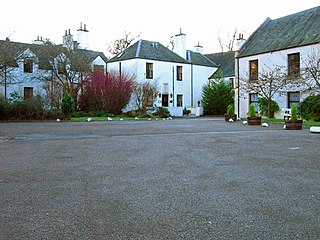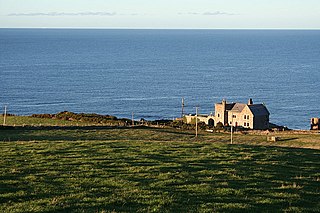Related Research Articles

Aberdeenshire is one of the 32 council areas of Scotland.
The Culdees were members of ascetic Christian monastic and eremitical communities of Ireland, Scotland, Wales and England in the Middle Ages. Appearing first in Ireland and subsequently in Scotland, attached to cathedral or collegiate churches, they lived in monastic fashion though not taking monastic vows.

Dufftown is a burgh in Moray, Scotland. While the town is part of the historic Mortlach parish, the town was established and laid out in the early 19th century as part of a planned new town settlement. The town has several listed 19th century buildings and serves as a regional centre for agriculture, tourism and services. The town is well known for its whisky based economy, as it produces more whisky than any other town in Scotland and is home to several existing and former distilleries.

Inverurie is a town in Aberdeenshire, Scotland at the confluence of the rivers Ury and Don, about 16 miles (26 km) north-west of Aberdeen.

Aberdeenshire or the County of Aberdeen is a historic county and registration county of Scotland. The area of the county, excluding the Aberdeen City council area itself, is also a lieutenancy area. The county borders Kincardineshire, Angus and Perthshire to the south, Inverness-shire and Banffshire to the west, and the North Sea to the north and east. It has a coast-line of 65 miles (105 km). The county gives its name to the modern Aberdeenshire council area, which covers a larger area than the historic county.

June 24 - Eastern Orthodox Church calendar - June 26
The Diocese of Aberdeen was originally believed to be the direct continuation of an 11th-century bishopric at Mortlach in present-day Moray. However, this early date and also the first bishops were based on a misinterpretation and reliance on early charters found in the cartulary of Aberdeen Cathedral that are now known to be false. The first recorded bishop of the diocese was Nectan, who was mentioned in the Book of Deer around 1132. The first direct written evidence of a bishop in Aberdeen is found in a papal bull addressed to Bishop Edward in 1157. This bull acknowledges the existence of his cathedral, discusses the formation of a chapter, and marks the start of the expansion of the diocesan structure.
Beóán of Mortlach is the first of the three known Bishops of Mortlach. His name, which could also be written in non-Gaelic contexts as Beanus, Beoanus and Beyn, means "lively one". Walter Bower, following John of Fordun, tells us that the bishopric was founded by king Máel Coluim II of Scotland in the seventh year of his reign as thanks to God for victories over the Scandinavians, and tells us that "the first bishop was Beyn, a saintly man, worthy of the episcopal office, elevated to this see by the Lord Pope Benedict VIII at the king's request". The Aberdeen Registrum records a charter granted to Bishop Beóán by King Máel Coluim at Forfar, granting the bishop the churches and lands of Clova and the unidentified Dulmech. The Aberdeen Breviary commemorated "Bishop Beóán" as a saint on 26 October. Another Beóán, perhaps the one mentioned in the Life of St. Cathróe of Metz, was commemorated on 16 December, and the two were often confused.

The Diocese of Aberdeen and Orkney is one of the seven dioceses of the Scottish Episcopal Church. Created in 1865, the diocese covers the historic county of Aberdeenshire, and the Orkney and Shetland island groups. It shares with the Roman Catholic Diocese of Aberdeen a Christian heritage that can be traced back to Norman times, and incorporates the ancient Diocese of Orkney, founded in 1035.

Saint Moluag was a Scottish missionary, and a contemporary of Saint Columba, who evangelized the Picts of Scotland in the sixth century. Saint Moluag was the patron saint of Argyll as evidenced by a charter in 1544, from the Earl of Argyll, which states "in honour of God Omnipotent, the blessed Virgin, and Saint Moloc, our patron". The House of Lorne became the kings of Dalriada and eventually united with the Picts to become the kings of Scots.

Fetternear Bishop's Palace is an archaeological site of what was one of the palaces of the medieval bishops of Aberdeen. It is near Kemnay in Aberdeenshire. Later, a ruined tower-house and mansion of Fetternear House were built on part of the site.
Monymusk Priory was a house of Augustinian canons based at Monymusk in Mar, Aberdeenshire. It began as a Culdee foundation but later became Augustinian.

Maryculter House is a historic house in the village of Maryculter, or Kirkton of Maryculter, in the Lower Deeside area of Aberdeenshire, Scotland.

Dundarg Castle is a ruined castle about 2 kilometres (1.2 mi) north-northeast of New Aberdour, Aberdeenshire, Scotland, built within the ramparts of an earlier Iron Age promontory fort. It was described by W. Douglas Simpson as one of the nine castles of the Knuckle, referring to the rocky headland of North-East Aberdeenshire, and by Charles McKean as "Scotland's answer to Tintagel". It became a small Celtic monastery for a period.

Hospitals in medieval Scotland can be dated back to the 12th century. From c. 1144 to about 1650 many hospitals, bedehouses and maisons Dieu were built in Scotland.
Ethernan was a 7th century Scottish martyr and saint.

St. Lesmo of Glen Tanar is the name given to a holy hermit who it is believed lived in Glen Tanar Aberdeenshire Scotland in the eighth century. He is recorded by Thomas Dempster as a "saint" in the seventeenth century. His claimed Saints’ Day is 9 December.

Mortlach Parish Church is a church within the Church of Scotland serving the parish of Mortlach, in Moray, close to the village of Dufftown. The site of the church has long been associated with Christianity, going back perhaps as far as 566 when St Moluag is said to have founded a religious community there. A Class II Pictish stone, dating from between the seventh and ninth centuries, was discovered there, which can now be seen in the burial ground. There was a bishopric on the site in the eleventh and twelfth centuries, prior to it being moved to Aberdeen in the reign of King David I. The current church retains some of the fabric of a thirteenth-century structure, which has been repeatedly remodelled in the centuries that followed, most recently in 1931. The church, along with the surrounding burial ground and a watch house within the grounds, has been designated a Category A listed building.

The Battle of Embo was a battle that took place at Embo in Sutherland, Scotland in 1245. It was fought by Scottish forces against Viking invaders who were defeated.
References
- ↑ Simpson, William Douglas (1922). A Forgotten Aberdeen Monastery. Aberdeenshire: Aberdeen UP. p. 2 . Retrieved 15 January 2019.
- ↑ Simpson (19 September 2023). Forgotten Monastery. p. 6.
- ↑ Simpson. Forgotten Monastery. p. 2.
- ↑ "Clova, St Luke's Chapel And Well". Canmore. Historic Environment Scotland. Retrieved 15 January 2019.
- ↑ "Clova". Canmore. Historic Environment Scotland. Retrieved 15 January 2019.
- ↑ Simpson. Forgotten Monastery. p. 3.
- ↑ Simpson. Forgotten Monastery. p. 3.
- ↑ Simpson (19 September 2023). Forgotten Monastery. p. 4-5.
- ↑ "Walking in the Footsteps of St. Moluag" (PDF). The Scottish Episcopal Church. Retrieved 15 January 2019.
- ↑ Simpson (19 September 2023). Forgotten Monastery. p. 5.
- ↑ Simpson (19 September 2023). Forgotten Monastery. p. 5.
- ↑ Simpson (19 September 2023). Forgotten Monastery. p. 5.
- ↑ Simpson (19 September 2023). Forgotten Monastery. p. 5-6.
- ↑ Simpson (19 September 2023). Forgotten Monastery. p. 6.
- ↑ Forbes, Alexander Penrose (1872). Kalendars of Scottish Saints. Edinburgh. p. 409 . Retrieved 15 January 2019.
{{cite book}}: CS1 maint: location missing publisher (link) - ↑ Law, James Duff (1903). Here and There in Two Hemispheres. Lancaster, PA: Home. p. 255 . Retrieved 15 January 2015.
- ↑ Jervise, Andrew (1875). Epitaphs and Inscriptions from Burial Grounds and Old Buildings in the Northeast of Scotland. Edinburgh. p. 1:261. Retrieved 15 January 2019.
{{cite book}}: CS1 maint: location missing publisher (link)